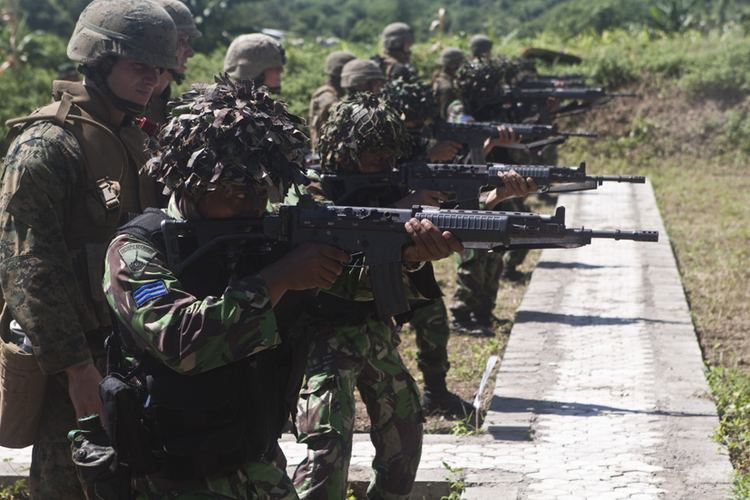The SS1 (short for Indonesian: Senapan Serbu 1, "Assault Rifle 1") is the standard assault rifle of the Indonesian armed forces and Indonesian National Police. It is based on the FN FNC rifle but modified in order to meet ergonomic and tropical environment needs.
The assault rifles are gas-operated automatic carbines with a foldable butt and are designed to meet the NATO standard. SS1 weapons are high performance light individual weapons that have been used by the Indonesian armed forces, including the Army, Navy, and Air Force, as well as police. It was adopted into Indonesian service in 1991.
It is currently being phased out and replaced by the Pindad SS2. The SS1 would possibly be used by reserve or paramilitary forces when the SS2 is fully adopted into service.
The SS1 is manufactured by PT Pindad, Bandung, Indonesia under the license from Fabrique Nationale, Belgium.
After 10,000 FN FNC rifles were bought for the Indonesian military, Pindad secured a license in 1984 from FN to manufacture the FNC. Indonesia adopted the SS1s into official service by 1991.
A recent seizure of Pindad SS1 rifles alongside P2 pistols in the Philippines has forced politicians to call on a special investigation on Pindad to whether weapon smuggling did take place according to Philippine customs officials. The Indonesian government, in response, has made preparations to form a special agency to handle all overseas trade. The Ministry of State Enterprises has conducted an investigation against Pindad over the seizure of Pindad-made firearms in the Philippines.
The external looks of the SS1s are strongly similar to the FN FNC, ranging from the pistol grip to the stock, receiver and barrel. Optics can be mounted onto the SS1 rifles, but a special optic mount be installed first before any optic can be used.
The SS1s are designed by Pindad to allow for the use of their own indigenous SPG-1A underbarrel grenade launcher, inserted underneath the barrel. Most SS1 rifle models, with the exception of the SBC-1, are made with selective fire modes that consist of single, three round and full auto firing modes.
SS1-V1The V1 is the primary variant, and is most widely used by Indonesian regular infantry forces, with standard barrel and foldable butt.
SS1-V2The short-barreled and compact carbine variant.
SS1-V3Standard barrel with fixed butt.
SS1-V4The designated marksman rifle variant similar to SS1-V1 except for the scope to extend the effective range during medium and long range firefights. Intended to be used similar in function to Dragunov Sniper Rifle.
SS1-V5The smallest variant of SS1 with a 252 mm barrel and 3.37 kg weight with foldable butt. Used by engineers, artillery forces, rear-echelon troops and by
special forces.
SS1-R5 RaiderAnother sub-variant of SS1 V5 called
SS1-R5 is designed for mainly special units within the Indonesian Military such as the special infantry Battalion
Raiders and other units such as
Kostrad or
Kopassus. The SS1-R5 is a lighter and slimmer design which doesn't sacrifice high accuracy. Designed for special forces operations such as
infiltration, short distance contact in jungle, mountain, marsh, sea and urban warfare. SS1-R5 can be attached with
bayonet and various types of telescopes. It has Safe, Single and Full Automatic firing options.
SS1-M1The modified SS1 intended for the
Indonesian Marine Corps. A special coating process ensures the SS1 M series to be able to hold up sea water and not easily rust. The variant is designed to function even after drenched in mud or sand. Available in 3 variants: SS1-M1, with a long barrel and foldable butt; SS1-M2, with a short barrel and foldable butt and SS1-M5 Commando.
Sabhara/Police V1-V2A variant created for police use. It's the only rifle in the SS-1 series chambered in 7.62×45mm (a necked-up version of the
5.56×45mm cartridge, utilizing a round-nose bullet similar to the .30 Carbine) created by PT Pindad for law enforcement conditions.
SBC-1A variant of the SS1-V5, made specifically for Indonesian customs as the rifle is named Senapan Bea Cukai (Indonesian for
Customs & Excise Rifle). Fires in single shot instead of full automatic.
SS2 series Cambodia: Exported in 1991. Indonesia: Komando Pasukan Katak (Kopaska) tactical diver group and Komando Pasukan Khusus (Kopassus) special forces group. Used by the Indonesian military. Mali: Confiscated by Philippine customs officials when a ship bound to Mali, passing by the Philippines to deliver 10 P2 pistols, was raided after arriving in Philippine waters. The Malian government has ordered 100 SS-1V1 rifles. The rifles were meant to be used by Malian Ministry of Internal Security and Civil Protection. According to Fernandino Tuason of the Customs Intelligence and Investigation Service, he has received credible information that certain politicians are planning to use the weapons, mostly Galils, for destabilization efforts for the presidential elections scheduled to be held in 2010. Pindad officials are clearing up the misunderstanding since the SS1 rifles are not Galils. The Manila Bulletin has been the only media outlet to check that the Galils are not Galil rifles, but SS1s. In addition, they are presenting evidence that the small arms shipment is legal. It's suggested that a gun-running syndicate is the culprit for getting Indonesian-made weapons to the Philippines. Nigeria United Arab Emirates: Exported in 1992.
